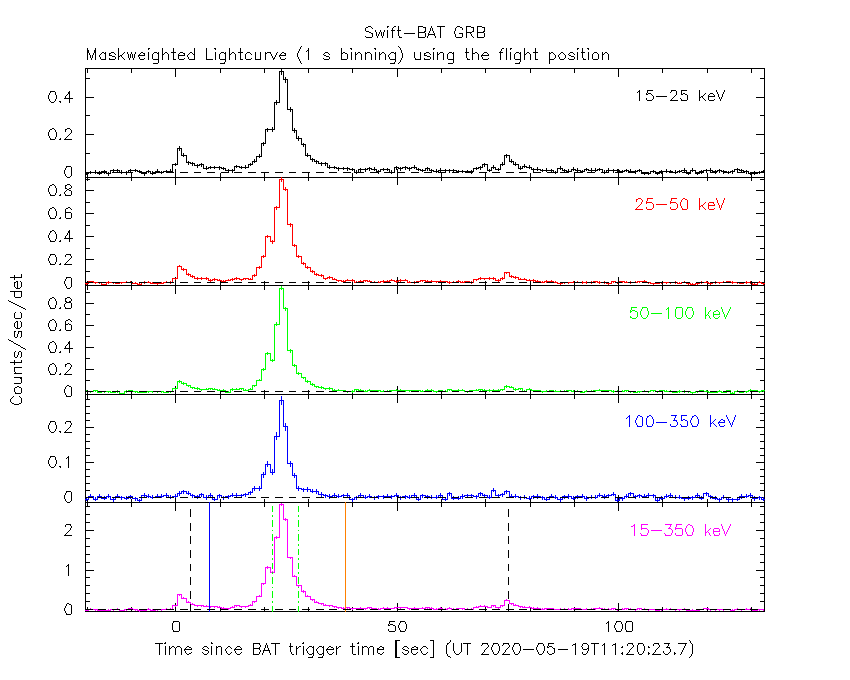
B. Sbarufatti (PSU), D.N. Burrows (PSU) and M.H. Siegel (PSU) for the Swift team
At 11:20:23 UT, the Swift Burst Alert Telescope (BAT) triggered and located GRB 200519A (trigger=973140) (Sbarufatti et al. GCN Circ. 27756). Swift slewed immediately to the burst. At the time of the trigger, the initial BAT position was 160° from the Sun (10.7 hours West) and 124° from the 10%-illuminated Moon. Table 1 contains the best reported positions from Swift, and the latest XRT position can be viewed at http://www.swift.ac.uk/xrt_positions.
Sbarufatti et al. (GCN Circ. 27756) reported the discovery with UVOT of an optical afterglow. Table 2 is a summary of GCN Circulars about this GRB from observatories other than Swift.
Standard analysis products for this burst are available at https://gcn.gsfc.nasa.gov/swift_gnd_ana.html.
As reported by Stamatikos et al. (GCN Circ. 27771),
the BAT ground-calculated position is RA, Dec = 255.319, -30.393 deg which is RA(J2000) = 1
The mask-weighted light curve (Figure 1) shows a multi-peaked structure that starts at ~
The time-averaged spectrum from T-0.45 to T+103.00 s is best fit by a simple power-law model.
The power law index of the time-averaged spectrum is 1.42 ± 0.03.
The fluence in the 15-150 keV band is 1.2 ± 0.02 x 1
The results of the batgrbproduct analysis are available at https://gcn.gsfc.nasa.gov/notices_s/973140/BA/.
Analysis of the initial XRT data was reported by Burrows et al. (GCN Circ. 27763). We have analysed 12 ks of XRT data for GRB 200519A, from 55 s to 154.8 ks after the BAT trigger. The data comprise 953 s in Windowed Timing (WT) mode with the remainder in Photon Counting (PC) mode. The enhanced XRT position for this burst was given by Osborne et al. (GCN Circ. 27761).
The late-time light curve (Figure 2) (from T0+4.8 ks) can be modelled with an initial rise, with a power-law index of α=-0.29 (+0.59, -0.22), followed by a break at T+6208 s to an α of 1.31 (+0.05, -0.04).
A spectrum formed from the WT mode data can be fitted with an absorbed power-law with a photon spectral index of 1.902 ± 0.029. The best-fitting absorption column is 4.35 (+0.17, -0.16) x 1
A summary of the PC-mode spectrum is thus:
Total column: 4.7 ± 0.5 x 1
Galactic foreground: 3.3 x 1
Excess significance: 4.7 σ
Photon index: 1.76 ± 0.08
The results of the XRT team automatic analysis are available at http://www.swift.ac.uk/xrt_products/00973140.
The Swift/UVOT began settled observations of the field of GRB 200519A 58 s after the BAT trigger
(Siegel and Sbarufatti GCN Circ. 27769).
A source consistent with the XRT position is detected in the initial UVOT exposures.
Table 3 gives preliminary
magnitudes using the UVOT photometric system
(Breeveld et al. 2011, AIP Conf. Proc., 1358, 373).
No correction has been made for the expected extinction in the Milky Way
corresponding to a reddening of

Figure 1. The BAT
mask-weighted light curve in the four individual and total
energy bands. The units are counts

Figure 2. The XRT light curve.
Any data from a crosshatched region are not included in the fit.
| RA (J2000) | Dec (J2000) | Error | Note | Reference |
|---|---|---|---|---|
| 1 |
-30°22'41.1" | 0.42" | UVOT-refined | Siegel and Sbarufatti GCN Circ. 27769 |
| 1 |
-30°22'43.3" | 1.4" | XRT-final | UKSSDC |
| 1 |
-30°22'41.7" | 1.8" | XRT-enhanced | Osborne et al. GCN Circ. 27761 |
| 1 |
-30°23'35.6" | 1.0' | BAT-refined | Stamatikos et al. GCN Circ. 27771 |
| Band | Authors | GCN Circ. | Subject | Observatory | Notes |
|---|---|---|---|---|---|
| Optical | Kong | 27757 | iTelescope optical afterglow detection | iTelescope | detection |
| Optical | Strausbaugh and Cucchiara | 27759 | LCO Optical Afterglow Detection | LCO | detection |
| Optical | Hu et al. | 27760 | BOOTES-3/YA optical counterpart observations |
BOOTES-3 | detection |
| Optical | Kumar et al. | 27764 | 1.3m DFOT Optical Afterglow Detection | Nainital | detection |
| Optical | Lipunov et al. | 27765 | Swift GRB 200519A: Global MASTER-Net observations report |
MASTER | |
| Optical | Kumar et al. | 27767 | GROWTH-India optical follow-up | GROWTH-India | |
| Optical | Kumar et al. | 27772 | R-band follow-up from HCT | Himalayan Chandra Telescope | detection |
| Gamma-ray | Gupta et al. | 27766 | AstroSat CZTI detection | CZTI | |
| Gamma-ray | Xiao et al. | 27770 | Insight-HXMT/HE detection | Insight-HXMT | |
| Gamma-ray | Marrocchesi et al. | 27773 | CALET Gamma-Ray Burst Monitor detection | CALET |
| Filter | Exp(s) | Mag | ||
|---|---|---|---|---|
| white | 58 | 208 | 147 | 15.43 ± 0.02 |
| v | 599 | 619 | 20 | 16.30 ± 0.16 |
| b | 525 | 545 | 19 | 17.13 ± 0.13 |
| u | 270 | 519 | 246 | 16.27 ± 0.04 |
| w1 | 648 | 840 | 39 | 17.46 ± 0.25 |
| w2 | 747 | 766 | 19 | >17.5 |
Table 3. UVOT observations reported by Siegel and Sbarufatti (GCN Circ. 27769). The start and stop times of the exposures are given in seconds since the BAT trigger. The preliminary detections and 3-σ upper limits are given. No correction has been made for extinction in the Milky Way.
May 22, 2020